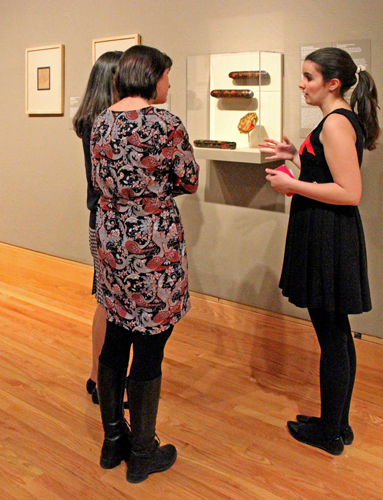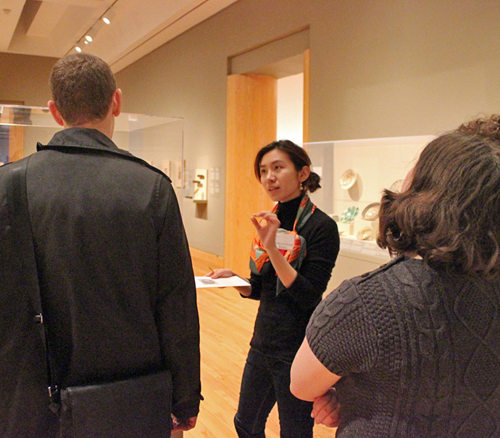What do you see when you look at a work of art, and how do you get others to look deeply at objects in a museum? What materials are works of art made from and why were they used? Where do you stand when you are presenting a work of art?
Over this past academic year, Harvard College undergraduates have been exploring such questions in a training program for student guides at the Harvard Art Museums. Taught by the collaborative team of Senior Museum Educator and curators from the department of Islamic and Later Indian Art, the course prepared students to design and lead thematic tours of the special exhibition In Harmony: The Norma Jean Calderwood Collection of Islamic Art. Teaching the program were Judy Murray, Senior Museum Educator; Mary McWilliams, the Norma Jean Calderwood Curator of Islamic and Later Indian Art; Mika Natif, Assistant Curator for Islamic and Later Indian Art; and Ayşin Yoltar-Yıldırım, the Norma Jean Calderwood Curatorial Fellow.
Because of the guides’ diverse knowledge sets—this year’s participants have academic concentrations in chemistry, comparative study of religion, English, and history of art and architecture—they bring unique perspectives to the collections, creating an invaluable experience for visitors who attend their tours. The guides designed individual tours for multiple audiences—fellow students, prospective freshman, the general public, and Harvard faculty, parents, and alumni—with themes as various as portraiture in Islamic art, changing aesthetics in Islamic ceramics, and representations of foreign women.
The training program began with an intensive nine-week course that provided students with an overview of Islamic art. Through a series of lectures, readings, and hands-on experience, students explored the range of the Calderwood Collection, which includes objects created between the 9th and 19th century and made with such diverse media as ceramics, works on paper, and Persian lacquer objects.
A formative moment in the students’ training came when Murray and the curators brought the guides to the Harvard Art Museums’ Straus Center for Conservation and Technical Studies. There they learned the steps conservators took to conserve and restore objects for this exhibition—a process that began over 10 years ago when the collection was acquired by the museums. The students were also able to hold ceramics and examine unframed paintings from the Harvard Art Museums’ collections, exposing them to new dimensions of how original works of art can be experienced. This special opportunity will be available to visitors in the three art study centers in the renovated Harvard Art Museums.
These encounters presented the guides with entry points for appreciating the objects they would talk about with visitors. Similar to piecing together a fragmented ceramic dish, each guide took their own pieces of knowledge—from their academic disciplines and conversations with museum staff—in order to build narratives to take with them into the galleries for their tours. When In Harmony was installed in January, Murray, Natif, and Yoltar-Yıldırım coached the guides as they practiced their tours with Harvard Art Museums staff. By March, the students were ready to give their first official tour during Harvard’s Junior Parents Weekend.
The student guide training program, which began in 2007, will be a hallmark of the renovated Harvard Art Museums. We look forward to growing this rich program in the museums’ expanded gallery space, where students will lead tours not only of special exhibitions but also the permanent collections.



